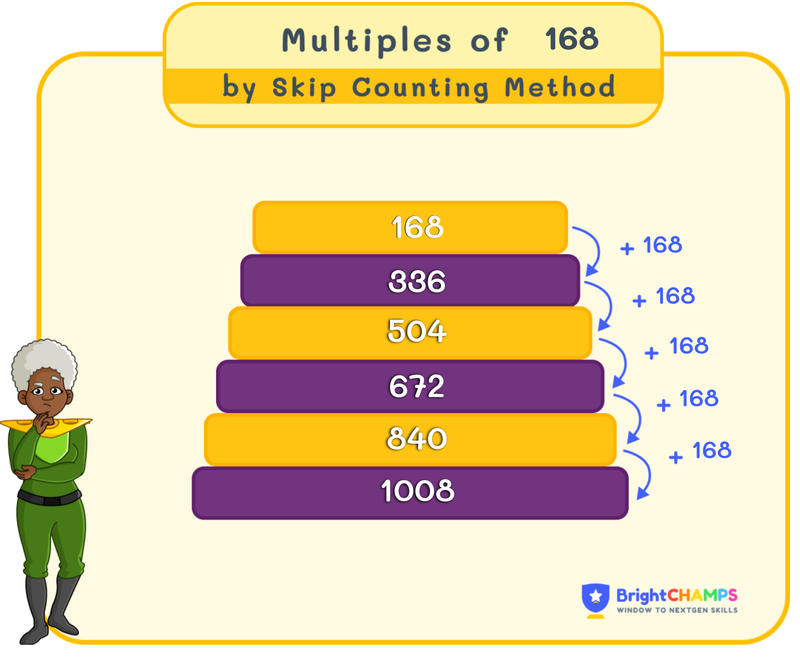
 171 Learners
171 LearnersLast updated on May 26th, 2025

Multiples of 168

In math, multiples are the products we get while multiplying a number with other numbers. Multiples play a key role in construction and design, counting groups of items, sharing resources equally, and managing time effectively. In this topic, we will learn the essential concepts of multiples of 168.
What are the Multiples of 168?
Now, let us learn more about multiples of 168. Multiples of 168 are the numbers you get when you multiply 168 by any whole number, including zero. Each number has an infinite number of multiples, including a multiple of itself.
In multiplication, a multiple of 168 can be denoted as 168 × n, where ‘n’ represents any whole number (0, 1, 2, 3,…). So, we can summarize that:
Multiple of a number = Number × Any whole number
For example, multiplying 168 × 1 will give us 168 as the product. Multiples of 168 will be larger or equal to 168.

Struggling with Math?
Get 1:1 Coaching to Boost Grades Fast !

List of First 20 Multiples of 168
Multiples of 168 include the products of 168 and an integer. Multiples of 168 are divisible by 168 evenly. The first few multiples of 168 are given below:
| TABLE OF 168 (1-10) | |
|---|---|
|
168 x 1 = 168 |
168 x 6 = 1008 |
|
168 x 2 = 336 |
168 x 7 = 1176 |
|
168 x 3 = 504 |
168 x 8 = 1344 |
|
168 x 4 = 672 |
168 x 9 = 1512 |
|
168 x 5 = 840 |
168 x 10 = 1680 |
| TABLE OF 168 (11-20) | |
|---|---|
|
168 x 11 = 1848 |
168 x 16 = 2688 |
|
168 x 12 = 2016 |
168 x 17 = 2856 |
|
168 x 13 = 2184 |
168 x 18 = 3024 |
|
168 x 14 = 2352 |
168 x 19 = 3192 |
|
168 x 15 = 2520 |
168 x 20 = 3360 |
Now, we know the first few multiples of 168. They are 0, 168, 336, 504, 672, 840, 1008, 1176, 1344, 1512, 1680,...
Operations with Multiples of 168
Understanding the multiples of 168 helps solve mathematical problems and boost our multiplication and division skills. When working with multiples of 168, we need to apply it to different mathematical operations such as addition, subtraction, multiplication, and division.
Sum of First 5 Multiples of 168
168, 336, 504, 672, and 840 are the first five multiples of 168. When multiplying 168 from 1 to 5, we get these numbers as the products.
So, the sum of these multiples is:
168 + 336 + 504 + 672 + 840 = 2520
When we add the first 5 multiples of 168, the answer will be 2520.
Subtraction of First 5 Multiples of 168
While we do subtraction, it improves our comprehension of how the value decreases when each multiple is subtracted from the previous one. 168, 336, 504, 672, and 840 are the first five multiples of 168. So, let us calculate it as given below:
168 - 336 = -168
-168 - 504 = -672
-672 - 672 = -1344
-1344 - 840 = -2184
Hence, the result of subtracting the first 5 multiples of 168 is -2184.
Average of First 5 Multiples of 168
To calculate the average, we need to identify the sum of the first 5 multiples of 168, and then divide it by the count, i.e., 5. Because there are 5 multiples presented in the calculation. Averaging helps us to understand the concepts of central tendencies and other values. We know the sum of the first 5 multiples of 168 is 2520.
168 + 336 + 504 + 672 + 840 = 2520
Next, divide the sum by 5:
2520 ÷ 5 = 504
504 is the average of the first 5 multiples of 168.
Product of First 5 Multiples of 168
The product of given numbers is the result of multiplying all of them together. Here, the first 5 multiples of 168 include: 168, 336, 504, 672, and 840. Now, the product of these numbers is:
168 × 336 × 504 × 672 × 840 = 32,895,883,776,000
The product of the first 5 multiples of 168 is 32,895,883,776,000.
Division of First 5 Multiples of 168
While we perform division, we get to know how many times 168 can fit into each of the given multiples. 168, 336, 504, 672, and 840 are the first 5 multiples of 168.
168 ÷ 168 = 1
336 ÷ 168 = 2
504 ÷ 168 = 3
672 ÷ 168 = 4
840 ÷ 168 = 5
The results of dividing the first 5 multiples of 168 are: 1, 2, 3, 4, and 5.

Common Mistakes and How to Avoid Them in Multiples of 168
While working with multiples of 168, we make common mistakes. Identifying these errors and understanding how to avoid them can be helpful. Below are some frequent mistakes and tips to avoid them:
Level Up with a Math Certification!
2X Faster Learning (Grades 1-12)


Multiples of 168 Examples

Problem 1
A city bus company schedules its buses to depart every 168 minutes. If the first bus departs at 6:00 AM, what time will the bus departing after 4 intervals leave?

12:12 PM
Explanation
To determine the bus departure time after 4 intervals of 168 minutes, calculate the total minutes by multiplying 168 by 4.
(168 times 4 = 672) minutes.
Converting 672 minutes to hours, we have 11 hours and 12 minutes. Adding this duration to the initial departure time of 6:00 AM results in 12:12 PM.

Problem 2
In an art exhibition, paintings are displayed in a sequence based on multiples of 168. If the first gallery displays 168 paintings, how many paintings are displayed in the first three galleries combined?

1008 paintings
Explanation
The number of paintings in each gallery follows the sequence of multiples of 168.
First gallery: (168 times 1 = 168)
Second gallery: (168 times 2 = 336)
Third gallery: (168 times 3 = 504)
Adding these together gives:
(168 + 336 + 504 = 1008)
So, the first three galleries have a total of 1008 paintings.

Problem 3
A factory produces batches of widgets every 168 minutes. If the factory operates continuously for 24 hours, how many batches of widgets will it produce in a day?

8 batches
Explanation
There are 1440 minutes in a day (24 hours). To find out how many batches are produced:
(1440 div 168 = 8.57)
Since only complete batches can be produced, the factory will produce 8 batches in a day.

Problem 4
A concert hall has a seating plan arranged in blocks of 168 seats. If during a special event, they fill 5 such blocks, how many seats are occupied in total?

840 seats
Explanation
To find the total number of occupied seats, multiply the number of blocks by the number of seats per block.
Number of blocks = 5
Seats per block = 168
(5 times 168 = 840)
Therefore, 840 seats are occupied in total.

Problem 5
A marathon race has checkpoints placed every 168 meters along the course. If the total length of the marathon is 42,000 meters, how many checkpoints are there?

250 checkpoints
Explanation
Divide the total length of the marathon by the distance between checkpoints to find the number of checkpoints.
(42000 div 168 = 250)
Therefore, there are 250 checkpoints along the marathon route.

Turn your child into a math star!
#1 Math Hack Schools Won't Teach!


FAQs on Multiples of 168
1.How do you find the multiples of 168?
2.What is the LCM of 7 and 168?
3.What are the real-life applications of Multiples of 168?
4.Are multiples of 168 finite or infinite?
5.Is there any odd multiple of 168?
6.How can poems help children in Bahrain memorize the Multiplication Table and Multiples of 168?
7.Can learning the Multiplication Table influence creativity in solving Multiples of 168 challenges for kids in Bahrain?
8.How do language and cultural differences in Bahrain affect the way children learn the Multiplication Table and Multiples of 168?
9.What role does brain development play in mastering the Multiplication Table and Multiples of 168 among early learners in Bahrain?
Struggling with Math?
Get 1:1 Coaching to Boost Grades Fast !

Important Glossaries for Multiples of 168
- Multiple: A multiple represents the product of a number that may be multiplied by an integer. For example, multiples of 168 include 168, 336, 504, 672, etc.
- Number Pattern: This refers to how numbers are listed. It should follow a certain sequence. Multiples of 168 are the numbers that consist of the number pattern of 168.
- Even Number: An even number refers to any number that can be divisible by 2 without leaving any remainder. The last digits of even numbers are 0, 2, 4, 6, or 8. All multiples of 168 are even numbers.
- Divisor: It refers to any number by which another number can be divided without leaving any remainder. 1, 2, 3, 4, 6, 7, 8, 12, 14, 21, 24, 28, 42, 56, 84, and 168 are the divisors of 168.
- Least Common Multiple (LCM): The smallest common multiple of two or more numbers. In this context, LCM can be used to find common multiples between 7 and 168, which is 168.
Explore More multiplication-tables
![Important Math Links Icon]() Previous to Multiples of 168
Previous to Multiples of 168
About BrightChamps in Bahrain


Seyed Ali Fathima S
About the Author
Seyed Ali Fathima S a math expert with nearly 5 years of experience as a math teacher. From an engineer to a math teacher, shows her passion for math and teaching. She is a calculator queen, who loves tables and she turns tables to puzzles and songs.
Fun Fact
: She has songs for each table which helps her to remember the tables




